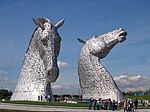Falkirk Stadium

The Falkirk Stadium is an all-seater football stadium in Falkirk, central Scotland, which is the home ground of Scottish League One club Falkirk and Lowland Football League club East Stirlingshire since 2018. The stadium has a capacity of 7,937 and currently consists of three fully completed stands. The stadium was opened in 2004 with the main stand completed. It became the home of Falkirk in the same year after the club ground shared Ochilview Park for the 2003–04 season whilst the stadium was being constructed. The north and south stands were built and opened in 2005 and 2009 respectively. East Stirlingshire have shared the ground since 2018, when they ended their own groundshare at Ochilview to return to Falkirk.
Excerpt from the Wikipedia article Falkirk Stadium (License: CC BY-SA 3.0, Authors, Images).Falkirk Stadium
Stadium Way,
Geographical coordinates (GPS) Address External links Nearby Places Show on map
Geographical coordinates (GPS)
| Latitude | Longitude |
|---|---|
| N 56.005277777778 ° | E -3.7527777777778 ° |
Address
Falkirk Stadium
Stadium Way
FK2 9DX , Westfield
Scotland, United Kingdom
Open on Google Maps










